Model Ship Basics
A Building Guide for Trumpeter's 1/350th Scale Z-25
By Rick Herrington
The objective of this article is to give you the basics on how
to build a ship model. The methods used in this article can be applied
to almost any kit model.
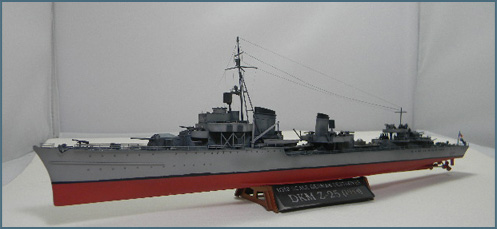
If you're just starting out building ship kits, you may want to tackle a less complex model than the Trumpeter Z-25 depicted here. Any one of
Tamiya's 1/700 scale ship kits would be a great starter. They are well engineered, fit well and do not require much filling or clean up. Built straight from
the box they build into a fine representation of the British, German, Japanese or American ship the model depicts.
The Trumpeter 1/350th scale Z-25 is a model of the German Narvik Class destroyer. The model depicts the ship as she was configured late in
World War II when allied air power was the main threat to German warships.
References
References
are an essential part of any build. Part of my reference for the
Z-25 build was an excellent publication put out by Squadron in 1979
called Kriegsmarine by Robert C. Stern.
CLOSE  |
CLOSE 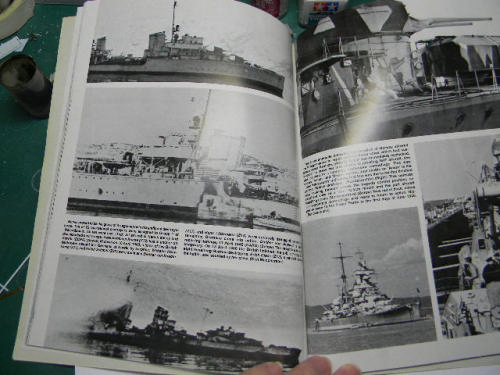 |
AJ Press puts out many excellent ship books although most of them are in Polish.
The internet is always a valuable source when researching the model you want to build also.
Model Art, a Japanese publication, puts out a good reference on German ships: German Warships of World War II.
CLOSE 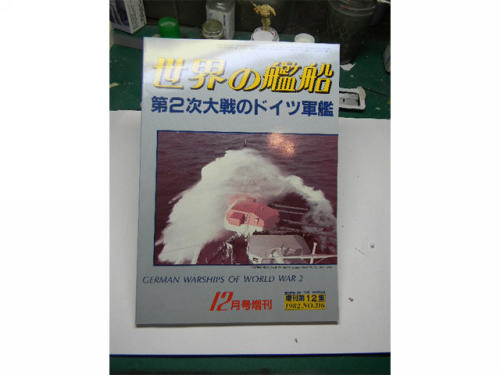 Kit-supplied
references can be a guide to build and paint from too. The illustration
below is the kit supplied color view of the X-25. Not all kits come
with color illustrations of the model. Older models just give you
the box top art and the instructions painting guide to work with.
CLOSE 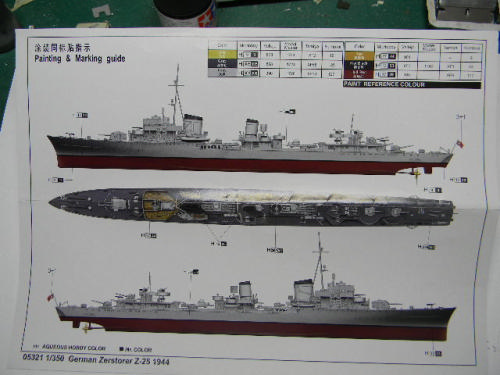 |
CLOSE 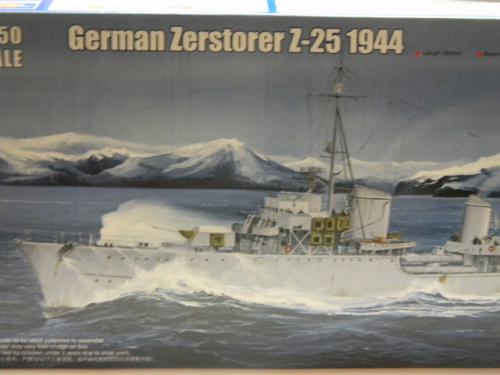 |
Once
you've researched your model or if you've skipped over this part
and want to dive straight into your opened box it's time to gather
the tools for your build.
Tools
- Exacto Knife
Essential in any model building project, the Exacto knife is used
for removing seam lines and general cutting.
- Plastic Clippers
Clippers are used to cut the plastic parts from the sprues the
parts are attached to. The closer you can nip to the actual part
when cutting it off the sprue, the less time you have to spend
cleaning up the part. Don't skimp when buying a pair of plastic
clippers.
- Tweezers
Tweezers are a big help in handling the small parts and in placing
and holding photo etch parts.
- Straight Edge Razor Blade
I get these at my local hardware store and use them as a backup
for my Exacto knife. Generally I use them to cut plastic and to
scrape seam lines.
- Nail Files
The least expensive of the tools I own. I get these from my wife
when she's finished using them on her nails. If you're not married,
they're available at your local grocery or drug store. I use these
for sanding and removing seam lines from parts.
- Liquid Glues
Liquid glue is the glue I use for assembling plastic models. It
gives me the control of being able to apply it where I want it
without an excess of glue. Tamiya glue dries faster than Testors
and melts the plastic faster than Testors. The bottle I use for
building is a 50-50 mix of each.
- Primer/Gap Filler
I use Tamiya Gap Filler to fill the small gaps that appear after
you glue parts together. I also use Gunze Sangyo Mr. Surfacer
500 and 1000. The difference between the Mr. Surfacers is the
thickness of the filler. The lower the number, the thicker the
liquid. The Tamiya white filler is on the thin side. I use the
thicker liquid for filling larger gaps. I also use thinned Mr.
Surfacer 1200 as a primer for my models. I thin it 50-75% with
Gunze Sangyo thinner and apply it with my airbrush.
CLOSE 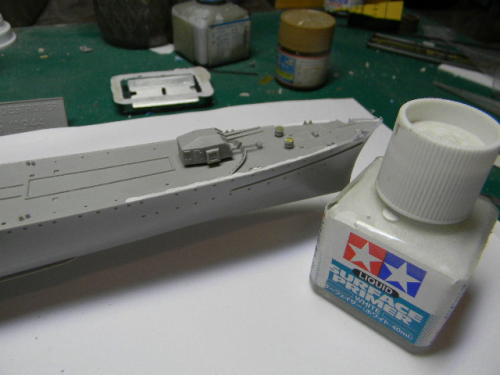 |
CLOSE 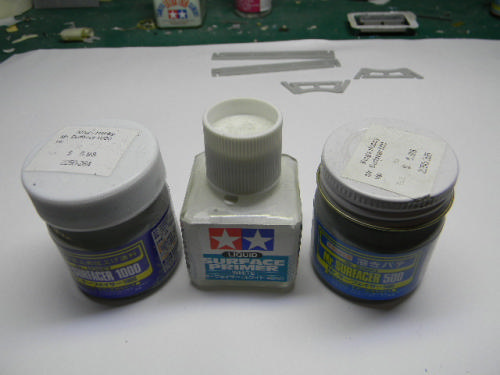 |
- Airbrush
An airbrush is not essential to completing a ship model. Brushes
will do almost as well. But if you're serious about modeling you
probably have one of these at home.
CLOSE 
Assembly
Some kits are easy to build. Some are designed where you rarely
have to glance at the instructions as the kits are so well designed.
The Trumpeter kit we're building is one where you have to pay close
attention to the instructions for the building process to go well.
Kit Instructions:
Kit Instructions are a vital part of your build. They can help or
hinder you greatly. Review them before you start building to make
yourself familiar with the way the construction sequence is laid
out and how you should approach it. Familiarize yourself with where
the parts on the plastic trees are located.
Getting started:
CLOSE 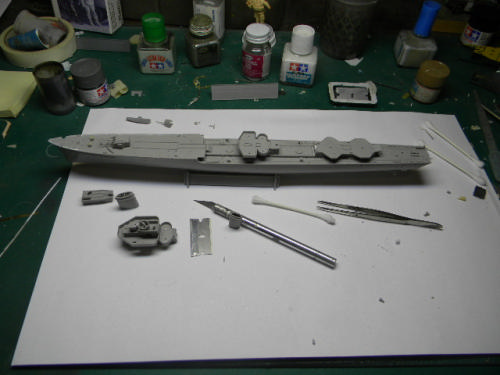 I won't spend too much time on construction of the model other
than to mention that with liquid glue you have to be careful as
it tends to act like a liquid. It flows everywhere including the
places you don't want it and on to fingers. I usually discover this
has happened after I find the finger print left on the side of the
hull. A little fine sand paper will fix the mistake, but if you're
careful you won't have to fix those kinds of mistakes.
Follow the instructions and pay attention to orientation of parts
on the instruction sheet. When you place a part incorrectly it may
make a difference in another assembly that fits together with it.
Depending on the part count in the kit (How many parts it takes
to build the kit) you may be able to finish your ship kit quickly
or in the case of the Z-25 spend a month building it.
I replace any molded on anchor chain with model railroad chain.
It comes in different links per inch and can be used for 1/700th
or in this case 1/350th. The first step is to scrape off the molded
on chain and sand the deck until smooth. Cut the railroad
chain to length and attach it to the model with super glue.
CLOSE 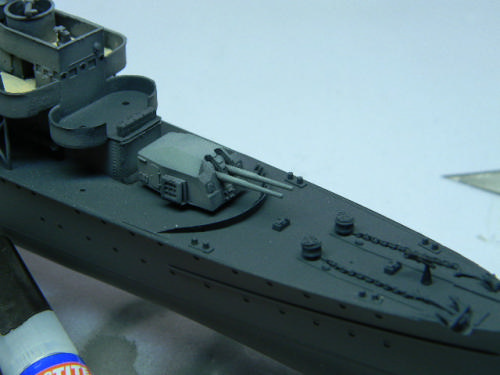 |
CLOSE  |
This small addition adds a lot to the overall look and feel of
your ship kit.
I paint my kits after I have them built. Others choose to build
sub-assemblies, paint them and then glue them together. I use a
lot of weathering techniques on my models such as pre-shading.
Pre-shading is painting your model with a dark color such as gray
or black and then misting the color you want over that base color.
This gives highlights and shadows to what otherwise would be a mono-tone
color scheme.
I put the photo etch parts on ships after the construction is finished,
unless it's going to be impossible to place a part after the ship
is constructed.
The picture below is well into the construction. I'm assembling
the smaller anti-aircraft weapons. These consist of 40 mm, 37 mm
and quad-20 mm's. The assemblies can be mini-kits in themselves so
be sure your follow the instructions carefully.
CLOSE 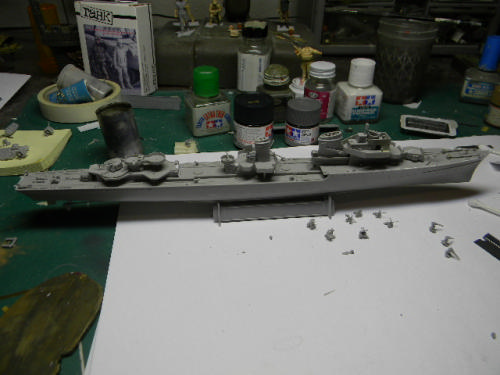 Painting
I paint my kits after I have them built. Others choose to build
sub-assemblies, paint them and then glue them together. If you are
using brushes to paint the Z-25 it would be better to paint the
sub-assemblies before gluing them on the ship.
Paint can make or break your model. Most people can ignore a few
construction errors if the model has a good finish. If you're a
beginner and using brushes to paint try to buy good brushes and
keep them clean. If you take care of your brushes they will serve
you well for many years. I use acrylic paints when possible (Tamiya or
Testors) as these are non-toxic and clean up with water.
I use a lot of weathering techniques such as pre-shading. Pre-shading
is painting your model with a dark color such as gray or black and
then misting the color you want over that base color. This gives
highlights and shadows to what otherwise would be a mono-tone color
scheme. The following sequence is how I paint my ships using a Badger
150 airbrush.
This is the model with the two base colors painted on (XF-50 and
XF-17). The weapons and mast will be painted separately and added
later. The deck is Tamiya XF-50 Field Blue. The rest of the ship,
including the superstructure, is painted XF-17 Sea Blue.
CLOSE 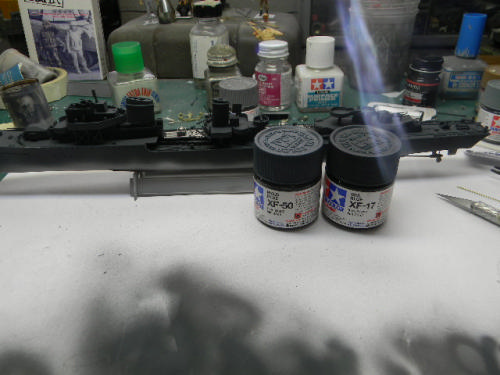 |
CLOSE  |
To do the highlight I switched to an enamel base paint made by
White Ensign Models. White Ensign puts out a line of paints designed
for ships. The color I used for the light gray is Hellgrau 50 (Light
gray 50).
CLOSE 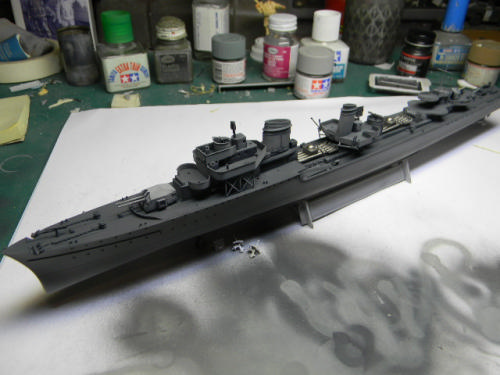 |
CLOSE  |
I lightly spray the Hellgrau 50 over the dark base colors allowing
them to show through to create variation in an otherwise mono-tone
color.
After masking the upper hull to protect the highlighted upper
hull, I used Xtracolor enamel red to paint the lower hull. Xtracolor
was not used because I prefer it. I used it because it was there
and I didn't have to go out and buy another bottle of paint.
CLOSE 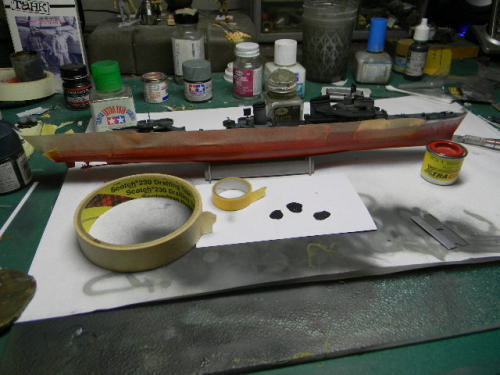 Kreiegsmarine warhips had a black stripe painted where the top
hull color met the hull red color. This was usually at the waterline
of the ship. The water around the ship in harbor was usually fouled
with oil and stained the light gray finish. The black stripe was
painted to hide the stains.
I used a Sharpie fine point pen to replicate the stripe, carefully
drawing the line between the red hull and the gray upper hull.
CLOSE 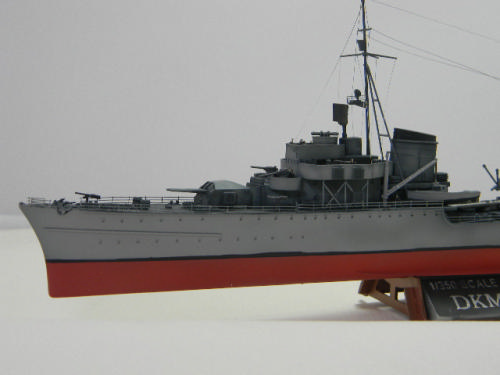 I used Alclad to paint the torpedo tubes although it would be fine
if you painted them gray like the rest of the hull. I painted them
metallic to draw the eye to the ship.
CLOSE  Wooden Decks
Almost all warships had some portion of the ship that was decked
in wood. This was usually teak. The purpose of the decking was to
give sure footing to the areas most travelled by the crew. The Z-25
was no exception in that the bridge decking was teak. I masked off
the surrounding areas with tape making sure the areas I wanted to
paint teak remained unmasked and then airbrushed White Ensign Models
deck teak color.
CLOSE 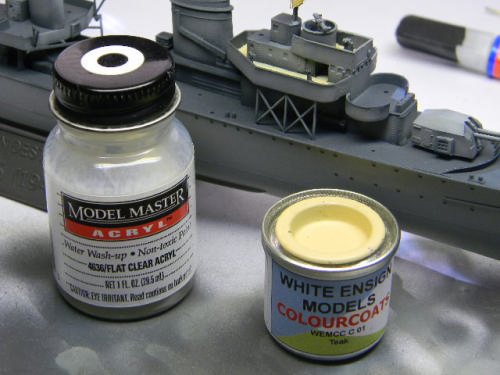 After letting this dry for several hours I sprayed the painted
area with Testor's acrylic flat coat.
CLOSE 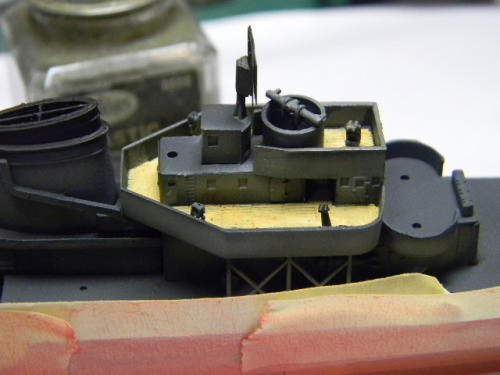 After the acrylic flat coat has dried for several hours the next
step is to use a mixture of turpentine, and black and raw sienna
oil paints. The mixture is 95% turpentine and 5% oil paint. The
liquid should take on a chocolate color. Apply this to the
teak deck. Applying this mixture gives variation to the teak color
and brings out the planking detail.
CLOSE  Photo Etch
Photo etch is usually a product you buy in addition to the model
to detail it even further. It is not necessary to add photo etch
to your ship model. If you are a beginner at ship modeling it would
be best to wait until you have a few kits built and your skills
sharpened before tackling photo etch.
Photo etch is usually for modeling the deck railings which in most
cases is not represented in the basic model. Some parts of the base
kit are molded heavily such as radars. Photo etch, because of its
delicate nature, represents these parts well.
The Z-25 came with basic set of photo etch. Gator glue and super
glue, the non-gel type, are musts when working with photo etch.
Gator Glue is a white glue which is easy to work with and dries
clear.
CLOSE 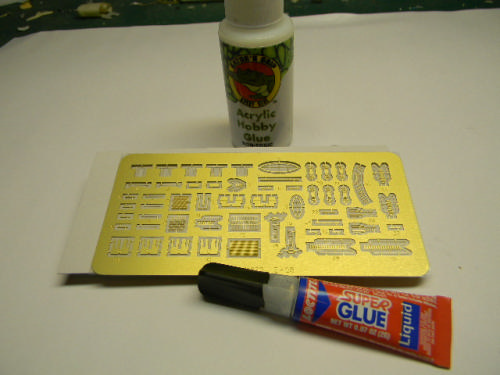 Use an exacto knife with a new blade to cut the photo etch parts
off their surrounding metal. I use a flat rock base to place the
part on and then use the blade to cut if off.
CLOSE 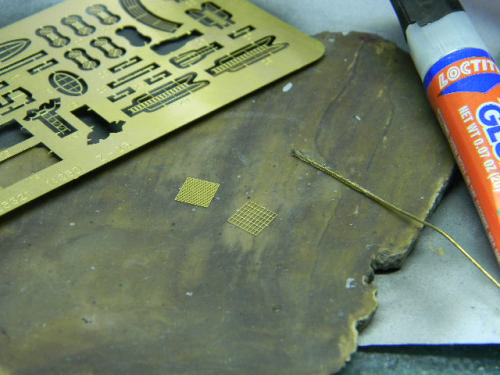 The photo above shows the two pieces that made up the photo etch
radar for the Z-25. It is made up of the screen and the frame for
the screen. These have to be glued together and then glued on to
the mast support on the bridge. The length of brass rod you see
on the stone is what is used for an applicator. It gives me control
over the super glue and allows me to place small amounts of the
glue on tiny parts.
CLOSE 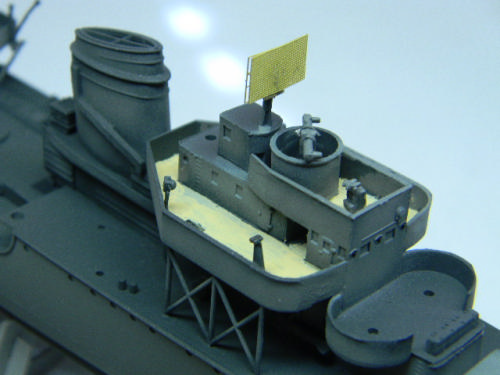 After it was installed I masked it off and painted it with Testors
Gun Metal Buffing Metalizer.
CLOSE  Photo etch can provide a lot of delicate detail that plastic molding
cannot. Just a few pieces can improve your model a great deal.
Safety railings that run along the edge of the deck and superstructure
are almost never supplied with a model kit. When they are supplied
in plastic they are usually out of scale and poorly done. Installing
photo etch railings on a ship, whether it be 1/700 or 1/350 scale
can be challenging.
Start by painting the railing the color of your ship. Measure the
length of railing you will need. I find it is easier to work with
shorter lengths of railing than longer. Try to find a breaking point
along the deck which is a logical place to end your length of railing.
CLOSE 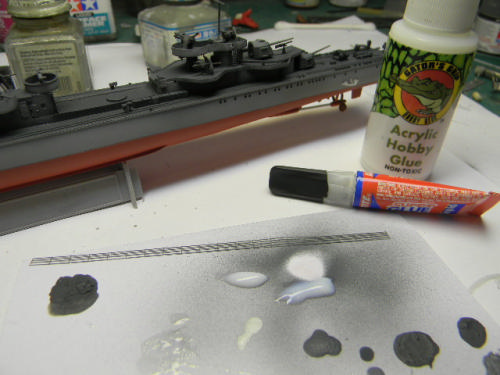 The length of railing I'm gluing on determines the
type of glue I use to do it. If it is a long length I use Gator
Glue and for shorter lengths I use super glue. I apply a pool of
the glue I'm using onto an index card and dip the bottom stanchions
into the glue and then attach them to the model. Depending on your
previous experience this may take one attempt or several. Don't
try to re-use a bent up piece of railing.
The picture below is of the Z-25 with the railings installed.
CLOSE  The mast on the Z-25 has a searchlight platform which has a rounded
railing. I have tried a number of ways to do rounded railing cheaply
including wrapping the railings around lengths of Evergreen
styrene tube but finally ended up buying the Mission Models Multi
Tool. The tool makes it a great deal easier to do rounded shapes
with phot etch with a lot less waste. The tool is the blue instrument
you see in the following picture.
CLOSE 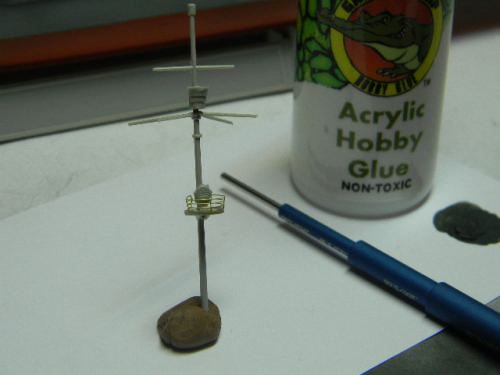 Rigging
Stretched sprue is an easy and inexpensive way to replicate the
rigging on a ship. Stretched sprue can be stretched in different
widths depending on what you need. If you're not familiar with it,
it is the process where you hold a kit sprue over a flame, usually
a candle, until it softens. At that point you stretch the sprue
pulling from both ends. This usually gives you a fine thread-like
length of plastic which you can cut to length. Because it is plastic
you can use your regular liquid glue to attach it from point to
point.
CLOSE 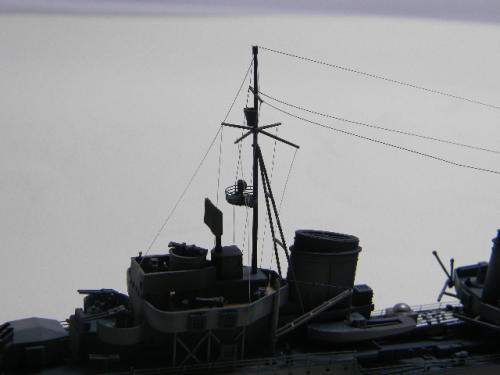 Crewmen
1/350th scale ships need crewman to look right. L'Arsenal, a French
company has a fine line of resin crewman for 1/350th scale ships.
There are 32 crewmen on the decks of my Z-25.
CLOSE 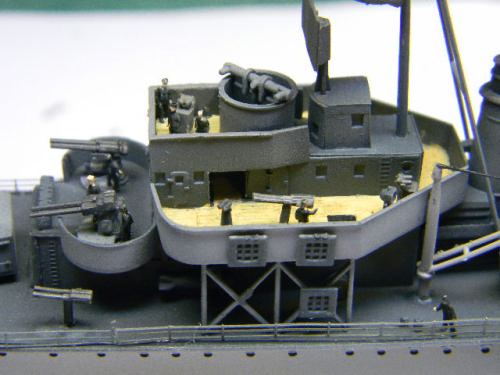 Flag
The last step in my model was adding a flag. This was a two sided
decal included in the kit.
I hope this article has simplified some of the techniques used
to build model ships. Depending on your skill level you may use
all or just a few to complete your ship model. Thanks for reading
and happy model building.
Click here for more articles.
| 